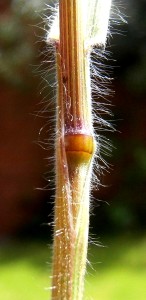One of the characters that marks out the Poaceae, the grasses, is the node.
Grass nodes are the funny “knobbly knees” on the grass culm (culm=the grass flower stem) and nodes are usually easy to spot. They maybe green or shades of brown or even reddish, round or elongated, hairy or glabrous.
Technically the node is the point at which two successive internodes meet and from whose meristematic tissue (= the intercalary meristem) leaves, adventitious roots and branches arise.
Meristematic tissues are cells or group of cells that have the ability to divide. These tissues in a plant consist of small, densely packed cells that can keep dividing to form new cells which form new leaves, roots and branches etc.
So, the nodes are found on the grass culm, and the culm is the flowering stem of the grass and therefore is quite unlike the smooth node-less flowering stems of rushes or sedges or other monocots – hence the useful monocot ID rhyme: “sedges have edges, rushes are round, and grass have nodes right down to the ground!”
Dr M has been investigating the value of the node for identifying grasses, and while this work is ongoing, Dr M is delighted to present here, for the first time, a collage of grass nodes! Hover your cursor over each image to see the identity of each node!
(NB these images are not to any common scale, so relative sizes between images can not be assumed).
STOP PRESS! To accompany this node-fest Dr M is composing a poem: “Ode to the Node”, which he will post soon! Keep your Poaceous eyes and ears open!













